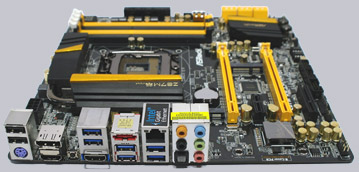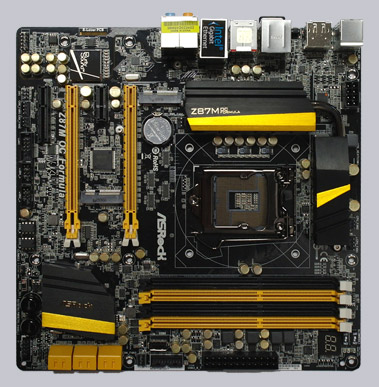
Result and general impression

++++ The ASRock Z87M OC Formula/M/ASR motherboard has a price of approx. 180 Euro (07/2013) and is thus in the upper price segment of the Intel LGA 1150 Haswell motherboards.
Awesome! This is how we could describe the brand-new ASRock Z87M OC Formula motherboard for Intel Haswell CPUs in the shortest mainboard review with just one word. We were also amazed about the plenty of features which can be integrated in such a small micro-ATX 8-layer PCB Z87 motherboard layout. ASRock offers especially very powerful options for overclockers with this LGA1150 motherboard. Overclock enthusiasts will have tears of joy in their eyes when looking in the UEFI Setup, so it is not surprising that ASRock earned our Overclocking Dream Award 07/2013 with this Z87M OC Formula. In the following detailed review, we examine the ASRock Z87M OC Formula and overclock an Intel Core-i5 4670K CPU with this OC motherboard.
The ASRock Z87M OC Formula LGA 1150 motherboard is delivered in this cardboard box:
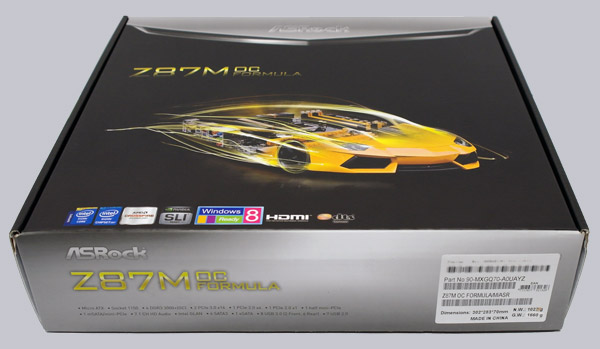
Here is a first look at the ASRock mainboard carton, where in addition to the usual manuals and utensils even small OC stands are included:
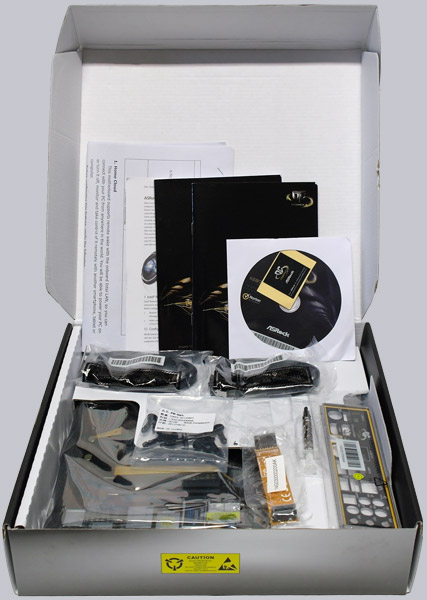
In order that the motherboard reach the user in perfect condition, it was carefully wrapped with foam and fastened with cable ties:
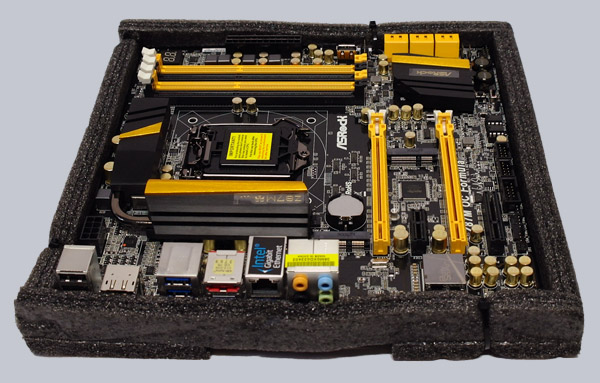
The ASRock Z87M OC Formula board is build with high-quality Premium Gold Caps Conductive Polymer capacitors and makes an amazing impression even of the smaller Micro ATX layout as well as the processing:
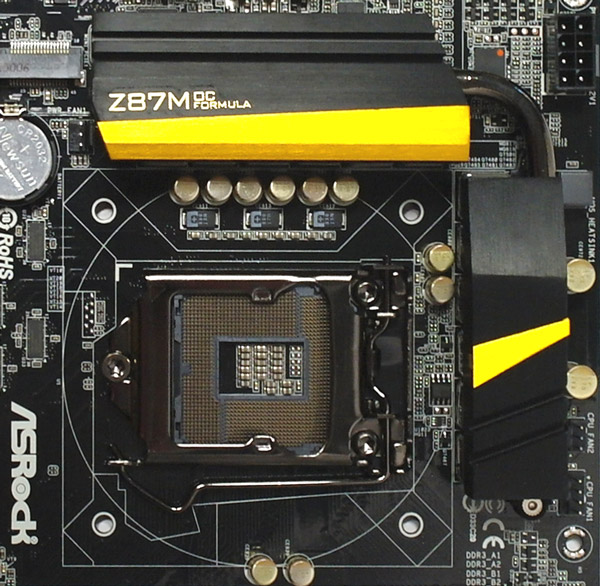
Here you can already see some interesting features, like the two high-quality, illuminated switches for power and reset, and the two BIOS ICs that can be independently selected with a small BIOS select switch:
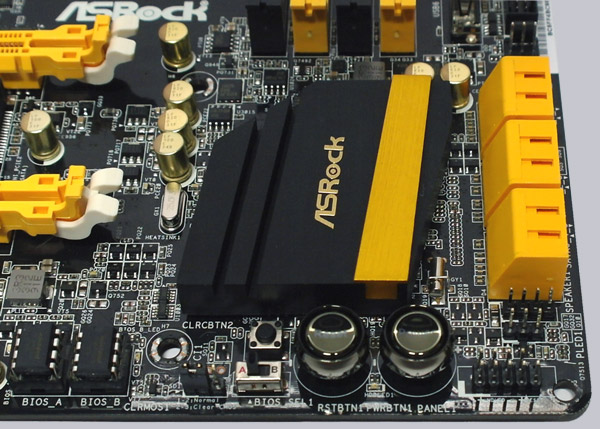
Another features are the additional internal USB-A port, the USB 3.0 headers, the Dr. Debug 7-segment LED post code display, the slow mode switch and the LN2 mode switch in the lower right:

Equipment and other features …
The ASRock Z87M OC Formula motherboard came with a manual, the above mentioned software setup guide, one DVD, foru SATA data cables, GELID Solutions GC-Extreme Thermal Compound, two fine screws for the mini PCI Express slots, a SLI bridge, 10 OC-stands and one ATX I/O shield. USB Slot brackets or the ASRock 3.5-inch USB3.0 frontpanel are optional available.
The OC formula features are so extensive that we cannot explain all of the features in detail in this review, but we explain some of the following features in the following review and for the completeness we want to mention at least some of them: ASRock Formula Drive, ASRock Instant Flash, ASRock Internet Flash, ASRock APP Charger, ASRock Fast Boot, ASRock Restart to UEFI, ASRock XFast USB, ASRock XFast LAN, ASRock XFast RAM, ASRock Crashless BIOS, ASRock Online Management Guard, ASRock UEFI System Browser, ASRock Dehumidifier Function, ASRock Easy RAID Installer, ASRock Easy Driver Installer, ASRock Interactive UEFI, NickShih?s OC Profile, Fine-Tuning V-Controller, Timing Configurator, ASRock Good Night LED, ASRock USB Key, ASRock Home Cloud, Purity Sound, HDMI-In, 12 Power Phase Design, 8 Layer PCB, ASRock FAN-Tastic Tuning and the ASRock Distortion-Free Slot.
Expansion cards …
The AMD CrossFireX / nVidia SLI motherboard offers two PCI Express 3.0 video card slots, whereby either one video card can operate with x16 band-width, or two with x8 lanes. A CrossFire bridge is included in the motherboard box, another special SLI/XFire switch card is not necessary to get the optimal performance for single or CF operation. If one like only use one video card on the Z87 OC Forumula, one should insert the PCI Express video card into the PCIE1 slot, in order to get the fastest x16 bandwidth. Additionally to the two PCI Express 3.0 slots there is one x4 PCIe 2.0 slot, one x1 PCIe 2.0 slot, one mini-PCIe slot (SATA 3_4 shared), one half-size mini-PCIe slot. PCI cards are not supported on this board.
Memory …
The ASRock Z87M OC Formula can be equipped with up to four DDR3 modules and is expandable depending upon operating system used (see list) to maximally 32 GB memory.
Here is a picture of the four DDR3 memory slots with dual channel support:
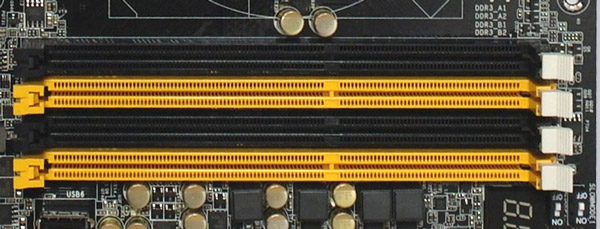
The Intel LGA1150 motherboard supports DDR3 memory modules and can be optimized in the BIOS for DDR3-1600 Dual Channel modules with an Intel Haswell processor. DDR3-1866, DDR3-2133, DDR3-2400, DDR3-2800, DDR3-2933, DDR3-3000 or higher clock-rates are currently only possible with overclocking. Thanks to XMP support (Intel eXtreme Memory Profiles), XMP memory modules be set correctly with one mouse click in the BIOS. There are of course far more memory adjustments and even higher overclocking features, but more on that later. You can also check the officially supported modules at ASRock’s memory support page.
Hard disk drive connectors …
The ASRock Z87M OC Formula offers no floppy connector or PATA connector for conventional IDE drives, but it offers six SATA3 connectors (6 Gb/s), one eSATA3 port at the I/O Panel and support for mSATA PCBs. The SATA3 ports supports RAID 0, RAID 1, RAID 10, RAID5, Intel Rapid Storage Technology 12 – RST12, Intel Smart Response Technology, NCQ, AHCI and the Hot Plug function in AHCI mode (AHCI stands for Advanced Host Controller Interface). Thanks to UEFI BIOS also drives with more than 2 TB for the installation of Windows 8, Windows 7 x64 or Vista x64 can be used.
The manual and the included DVD contains all basic information to manage a new installation of Windows Vista, Windows 7 or Windows 8 with SATA3 drives, and how to manage a RAID installation. 32-Bit and 64-Bit drivers for Windows 8 and Windows 7 are provided on the DVD and can be downloaded on the ASRock support page.
Here you can see the six SATA3 ports:
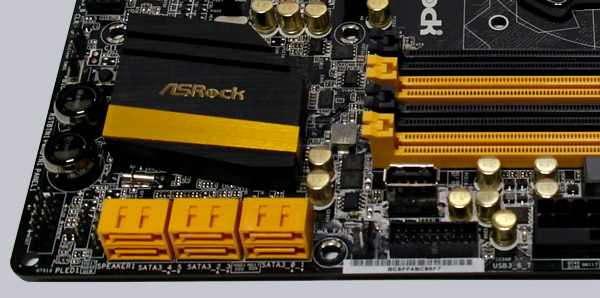
The space between and near the PCIe slots is used optimally, to install for example a half-size mSATA SSD or an mSATA SSD or the ASRock WiFi module:
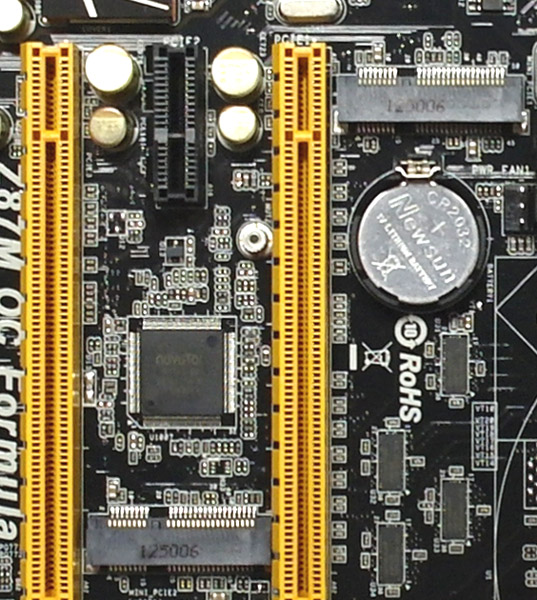
USB and Firewire …
The board has nothing less than six USB 3.0 connectors at the ATX-panel, two USB 2.0 connectors at the ATX panel, two internal USB 2.0 plugs for up to four optional USB ports and one more internal USB 3.0 plug for up to two optional USB3 ports. The 20-pin connector can be connected either to an optional USB3.0 front panel or to an enclosure with USB3.0 ports. A very special feature of the OC formula is the additional internal USB 2.0 port that is integrated directly on the mainboard, so within the PC case and thus internally can be reached. This is often very useful, e.g. for an internal connection of an USB Ultra IR receiver kit, an USB memory stick or for an UMTS stick. However you should be careful using this USB port and always look where you exactly stick the USB, as internal connections usually are equipped with plastic connectors, to avoid an accidental short circuit with exposed contacts.
Hint: One should install the new ASRock XFast USB software to accelerate the USB transfer rate e.g. for USB sticks clearly. Who uses Windows 7 or Windows 8, should also install the ASRock XFast RAM software, which we have discussed already several times in some forum posts.
Network …
The ASRock Z87M OC Formula motherboard is provided with the Intels I217V solution which offers a 10/100/1000 network connector on the I/O panel. The LAN connection is WoL capable, offers LAN cable detection, supports energy efficient 802.3az ethernet and supports Intel Remote Wake Technology.
Serial and parallel port …
This motherboard does not provide a parallel port. The serial port is optionally available as internal connector on the motherboard.
Sound …
The ASRock Z87M OC Formula motherboard is equipped with the ALC1150 audio codec with content protection, 115dB SNR DAC, TI NE5532 Premium Headset Amplifier and Purity Sound, which supports 7.1 surround sound for example analog over 5x 3.5mm connectors on the ATX panel or over an internal frontpanel audio connector.
For the digital output there is an optical digital SPDIF output, THX TruStudio support and premium Blu-Ray audio support. So most users don’t need to buy an additional sound card with digital outputs.
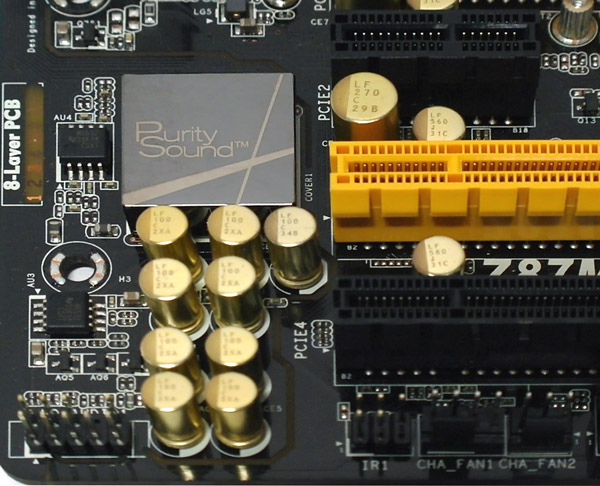
Graphics …
The new Intel Z87 chipset offers in combination with an Intel Haswell processor a full integrated Graphics Technology (GT) graphics solution with DX11 support. Depending upon processor used there is e.g. an Intel HD Graphics 4600 graphics unit, whereby the Intel Core i5-4670K CPU used in this test is equipped with the HD Graphics 4600.
A very special feature of this Z87M OC formula motherboard is the additional HDMI input, which allows the connection of an external HDMI device like another PC, a cable or satellite receiver or a Smartphone with HDMI output. Of course we have also tested this nice feature and could switch between the PC picture and the external HDMI device during operation using the key combination ALT + C. Here you can see both HDMI ports:
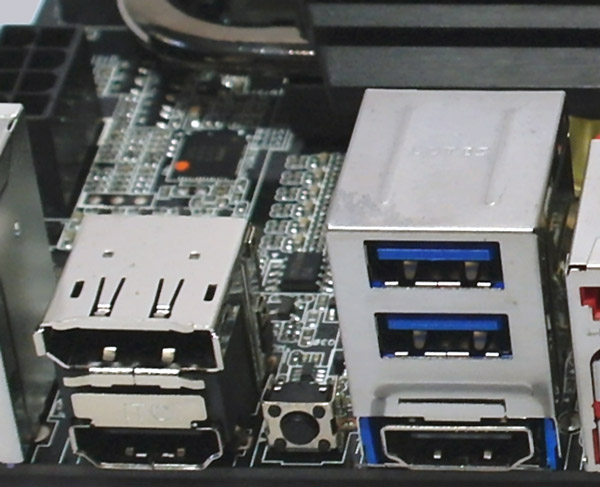
Over UEFI setup,the graphics unit can be overclocked from 50 to 3000 MHz, but the Intel HD Graphics 4600 GPU has even without overclocking an awesome performance. So the GPU of the Intel Core i5-4670K CPU achieved in Windows 7 with 3DMark 48116 Ice Storm points, with 3DMark11 Entry 2565 3DMarks and with 3DMark06 7864 3DMarks !
In comparison, the AMD HD7660D GPU of an AMD A10-5800K APU reached on the ASRock FM2A85X Extreme6 in 3DMark06 7651 3DMarks, the HD6550D GPU of the AMD A8-3870K FM1 APU reached on the ASRock A75 Pro4 motherboard 6181 3DMarks, an Intel HD Graphics Unit of the Intel Core i5-2500K CPU on an ASRock H77 Pro4/MVP achieved with 3DMark06 in Windows 7 a benchmark score of 4310 3DMarks, an AMD HD 4290 IGP of the AMD 890GX chipset achieved with an AMD Phenom II 710 X3 processor on an ASRock 890GX Extreme4 a 3DMark06 score of 2204 points. Furthermore the integrated video processor supports DirectX 11, HDCP, Full HD 1080p and offers thanks to its onBoard HDMI connector and the low power consumption optimal conditions for a tiny Gaming PC.
ATX backpanel connectors …
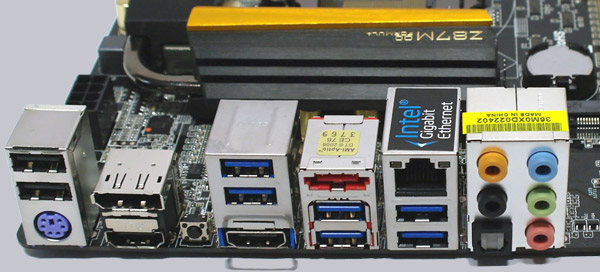
From left to right, one can see 2x USB 2.0 ports, the PS/2 connector for a PS/2 keyboard, DisplayPort and HDMI Out, Clear CMOS button, 2x USB 3.0 and HDMI In, eSATA3 and 2x USB 3.0, RJ45 Gigabit LAN and 2x USB 3.0, optical SPDIF out and 5x 3.5mm jacks for analog sound.
BIOS and Overclocking …
Let us continue with BIOS / UEFI Setup options and UEFI overclocking. By pressing F2 or Del during the PC boot, you get access to the UEFI Setup.
The ASRock UEFI BIOS of the Z87M OC Formula offers a graphical surface for an intuitive operation with a mouse or with a keyboard, depending upon desire. User with an USB mouse and USB keyboard should not deactivate the Legacy USB support in the BIOS with the USB Configuration, because otherwise they can not access the UEFI Setup. In the Auto mode the board decides if the USB device need to operate in Legacy mode. Keyboard and Mouse should be still connected to the USB 2.0 ports.
Another new feature is the “Active Page on Entry” selection, where you can decide which UEFI page you want to see when you enter the UEFI Setup. This is mainly very helpful for overclocking since one have to go very often in the second OC Tweaker menu to find the best OC settings, so ASRock offer it for less mouse clicks.
Here you can see the Z87M OC formula UEFI surface with the new active page on entry menu:
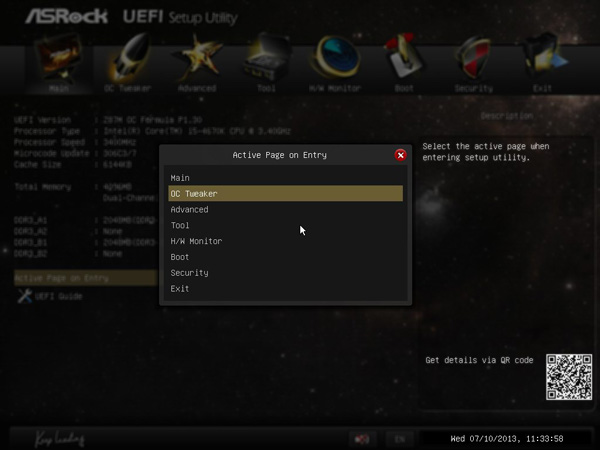
The graphical UEFI BIOS interface allows even a language, e.g. German:
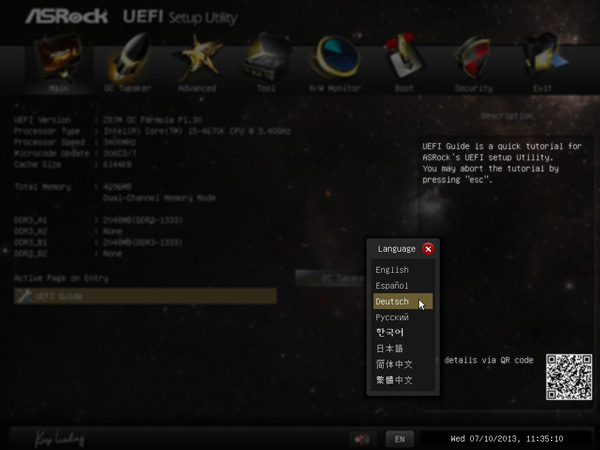
However, English language selection is still recommended, because the translation is rather confusing:
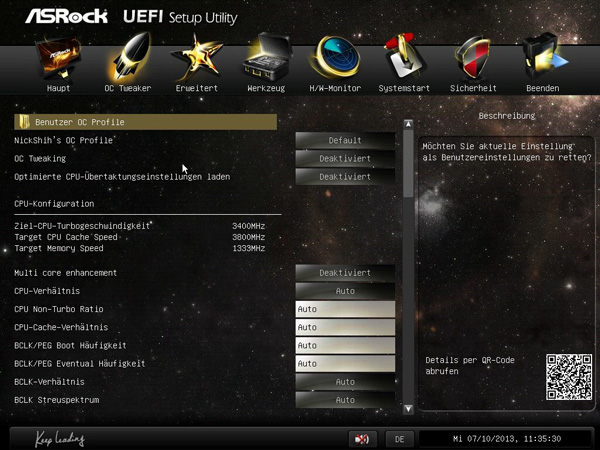
You should leave the language selection in English, since most expressions are already English and can be poorly translated.
UEFI BIOS Update …
ASRock offers several ways to update the BIOS and one very comfortable option to flash BIOS updates is the so-called ASRock Instant Flash or ASRock Internet Flash option with direct access to the internet.
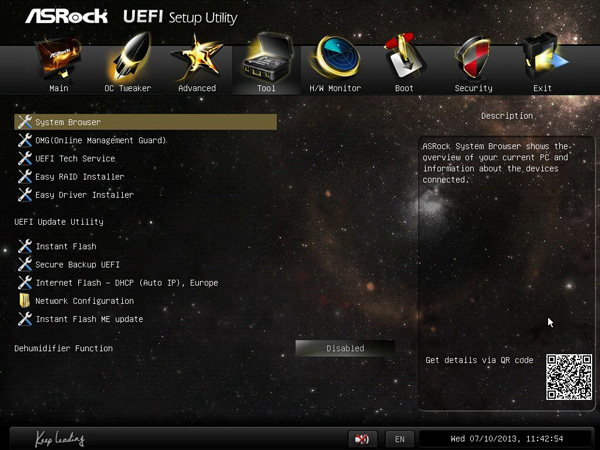
One can get into the ASRock Instant Flash utility in the Advanced BIOS or by pressing F6 during the PC start. Hereby one can very easy upgrade a downloaded ASRock BIOS without further boot CD, USB boot stick, etc. Just start the ASRock Instant Flash utility and select a BIOS Flash ROM from the device like an USB Stick to flash the BIOS without an additional boot medium. If you need technical help about the UEFI, you can contact the ASRock over the UEFI Setup and LAN connection. Furthermore, this motherboard is equipped with a backup BIOS and by the “Secure Backup UEFI” option one can update with a working BIOS from the other BIOS EEPROM and select the preferred BIOS chip at any time over the BIOS switch.
The motherboard came with BIOS M1.21A. At review date, the UEFI BIOS Version P1.30 was the latest version for download.
How to overclock the motherboard …
The Z87M OC Formula UEFI Setup offers amazing settings, which leaves nearly nothing to be desired. For the DDR3 memory, this board supports settings like e.g. the memory frequency from DDR3-1066 over DDR3-1333, DDR3-1600, DDR3-1866, DDR3-2133 up to amazing high DDR3-4000 or with BCLK overclocking even higher.
Here you can see the DDR3 frequency selection at default 100 MHz BCLK:
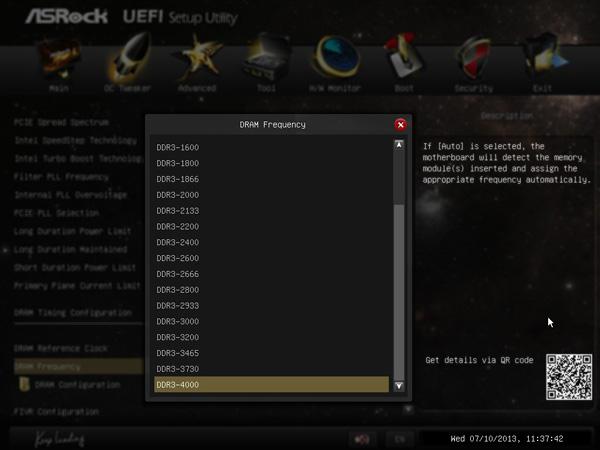
The frequency of all memory modules is calculated and shown after changing the reference clock to make it much easier adjusting the right RAM frequency. Up to DDR3-4000 can be selected in the BIOS and higher DDR3 frequencies above DDR3-4000 are possible with manual overclocking over the BCLK. Thanks to the XMP support, XMP memory modules ca be set correctly with one mouse click in the UEFI, selecting the desired profile in the DRAM configuration, but this Z87 OC Formula offers much more.
In the DRAM Tweaker menu, you get a very good overview of all the values to choose from:
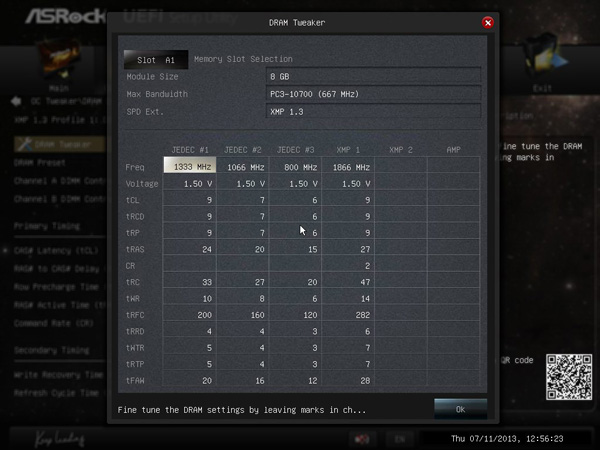
Even for the DDR3 Boot voltage ASRock has come up something new and now allows adjusting the setting with a slider:
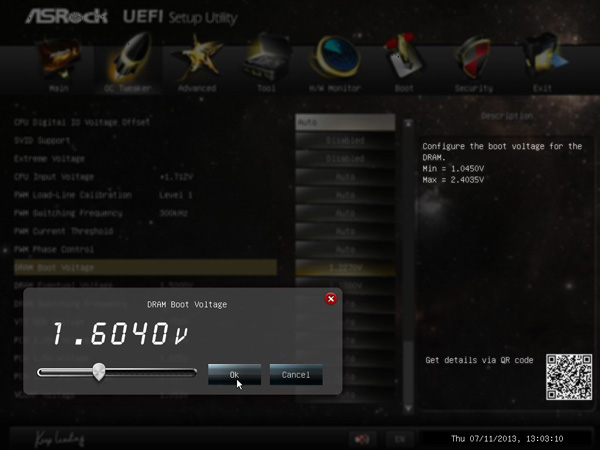
For CPU overclocking, ASRock offers a clearly arranged OC Tweaker menu in the UEFI Setup. Here you can see a snippet of the great OC Tweaker setting possibilities:
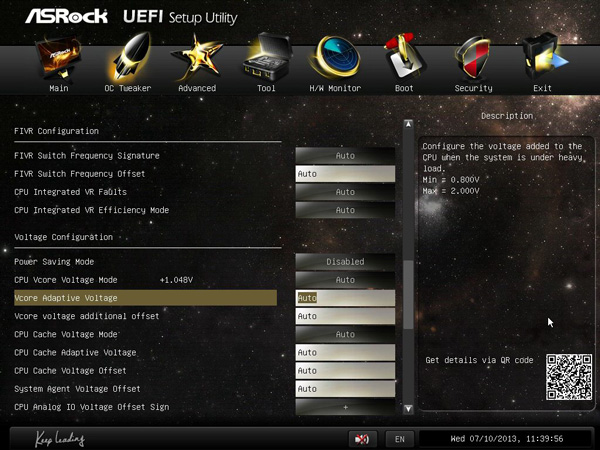
In this menu one can set the BCLK/PEG frequency from 95 MHz to 300 MHz. This frequency is very important for a lot of frequency values with Intel Haswell processors as well as already known from Sandy Bridge and Ivy Bridge processors, which can get quickly too high. For this reason, you should only carefully increase the BCLK host clock and also adjust the BCLK ratio, to increase it to 125 MHz, 167 MHz or even higher.
In the review the motherboard could be stable overclocked on a BCLK of 170 MHz.
Buyers of an Intel “K” CPU have an unlocked multiplier and may want overclock the CPU frequency very extensively over the CPU multiplier. With a 4670K CPU (default clock 3400 MHz with a CPU ratio of 34x), the ASRock Z87M OC Formula motherboard offered a multiplier range from 8x to 255x, which mathematically at 100 MHz BCLK could be a frequency of 800 MHz up to 25500 MHz.
You could adjust the Turbo from 8x to 120x, which resulted in a boot screen with 12,000 MHz:
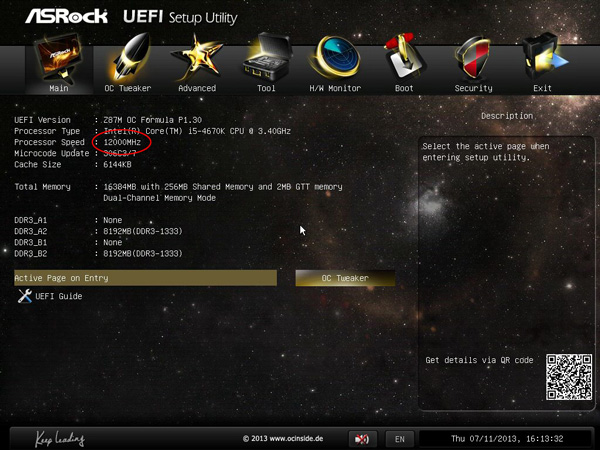
Of course, the CPU would stop working immediately under load, so this CPU frequency of 12 GHz with the Turbo is very nice to look at, but unfortunately a pretty unrealistic value for this CPU.
The GPU clock of the integrated graphic unit can be adjusted from 50 to 3000 MHz.
The boot failure guard was also examined in the test and could start the PC even at high Übertaktungswerten without CMOS clear with standard frequencies. ASRock leaves the user with the “Boot Failure Guard Count” Option which will boot choice, how often the board should boot with fault settings before it automatically reduces the frequencies. If it accidentally succeeds that the PC fails to boot, you can also set the CMOS clear button, the stored values in the profile fortunately remain and can be loaded very fast.
Furthermore, the Board has such a numerous of power settings, that OC’s will get tears of joy in their eyes, it offers with the Intel Core i5-4670K test processor e.g. a VCore selection of 0.800 up to 2.000 Volt and +0.001 to +1.000 offset, an IGPU voltage of 0.800 to 2.000 Volt and GT voltage offset between +0.001 and +1.000 Volt, PCH 1.05V chipset between 0.778 – 1,656V, VTT voltage 0.768 to 1.634 Volt, VCCSA system agent voltage offset +0.001 to +1.000 Volt, CPU cache voltage of 0.800 up to 2.000 Volt and +0.001 to +1.000 offset, CPU input voltage 1.200 – 2.300V, CPU analog IO voltage offset from -1.000 to +1.000, CPU digital IO voltage offset -1.000 to +1.000, PCH 1.5V voltage (I/O) 1.106 – 1.835 Volt, PCH IREF 1.5 voltage 1.106 – 1.835 Volt, VCOMP voltage 0.773 – 1.657 Volt, primary plane current limit, Short Duration power limit, Long Duration power limit, internal PLL Overdrive voltage, SVID support, PCIE PLL selection, Extreme voltage, PWM Switching frequency from 300 to 600 KHz, DRAM switching frequency from 600 KHz to 1 MHz, CPU Load Line Calibration from 1 to 5 and more boost options that allows more room for overclocking.
The DDR3 voltage could be increased in the BIOS between 1.045 and 2.4035 Volt, which should be enough voltage even for DDR3 OC modules with LN2 cooling.
With regard to liquid nitrogen cooling a lot of features are integrated as well on this board, because the OC Formula series from ASRock is designed to meet even the demands of extreme overclockers. Among the above mentioned LN2 switch was integrated, to fix liquid nitrogen cold start problems and there are still a lot of more interesting UEFI settings for LN2 cooling.
Another special OC Formula feature is that some OC profiles of NickShih with LN2 OC values are stored in the UEFI Setup, here is a screenshot of the OC profiles:
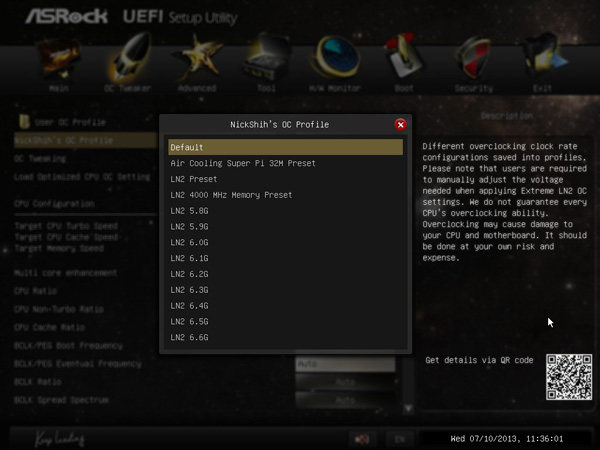
If these are too many values for you, one can also easily load Optimized CPU OC Settings, to try your overclocking with predefined OC settings. They can increase the system performance automatically by overclocking in different Turbo steps – at least with some luck and if it is possible with your components. Simply select the desired boost setting, then some components and the CPU are overclocked, e.g. to a desired value of Turbo 4.0 GHz or Turbo 4.4 GHz – that’s really easy. However, you should still better set each value manually, that you are able to adjust all values for the respective hardware.
Of course we will give you overclocking help in our OC Forum (German and English).
In addition, one can store several different BIOS settings with a desired name. Thus one can save for example balanced BIOS settings, overclocking settings and underclocking settings in a user profile of the BIOS to load them very quickly at any time.
Here is a screenshot of the user profiles:
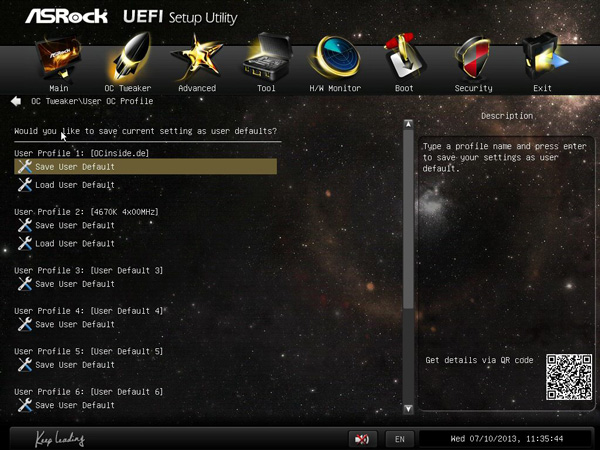
BIOS Undervolting …
The downclocking or underclocking was also tested in this review. It was possible to lower the Intel Core i5-4670K CPU multiplier over the BIOS to 8x and the processor can be underclocked in such a way with 95 MHz BCLK to approx. 760 MHz. Underclocking is like OverClocking outside of the manufacturers specification, so it is necessary to have a bit luck, but ASRock gives several options for easy PC underclocking / downclocking.
The BIOS and the ASRock Extreme Tuning Utility of the passive cooled Z87M OC Formula motherboard offers a CPU Quiet Fan option (temperature fan control) for a 4-pin CPU fan, a 3-pin CPU fan and the 4-pin chassis fan 1 and 3. Chassis fan 2 can be adjusted manually, so it is not necessary to buy an additional fan controller.
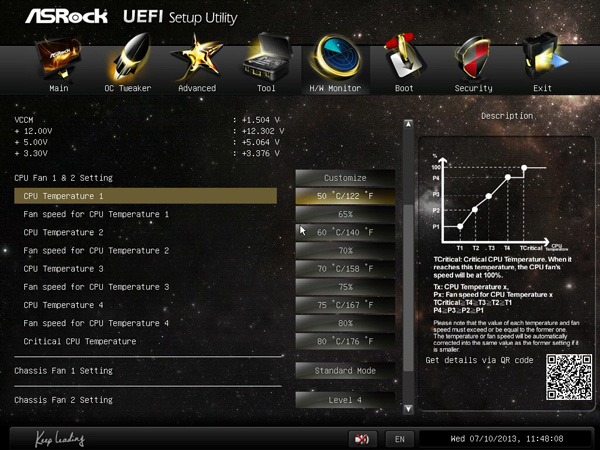
The fan control can also be set under tools using ASRock’s Formula drive software supplied to easily adjust the fan controller in Windows. Here is a screenshot of the FAN-Tastic Tuning page:
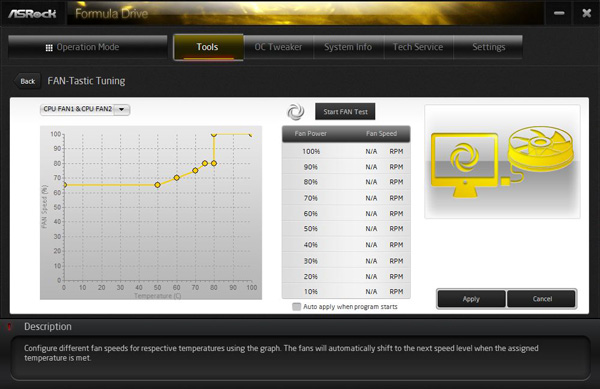
OC adjustments and the temperature monitoring can be done by the way as well easily with the supplied ASRock Formula drive software under the point “OC Tweaker”.
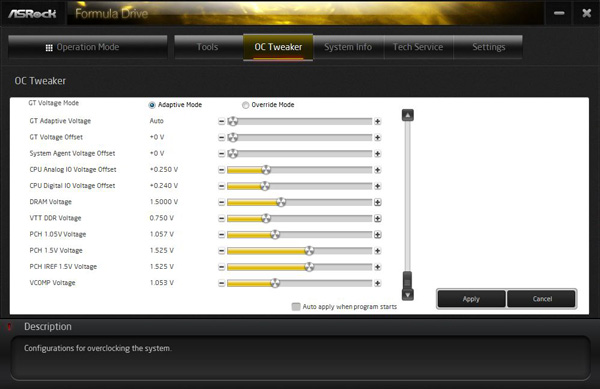
Power consumption …
Power consumption will vary depending upon the hardware and upon the PC load. The current consumption of the test PC with Intel Core i5-4670K CPU, 4GB DDR3-1333 memory, hard disk drive and Cooler Master Silent Pro M 600W test PSU was without overclocking depending upon load: – With Sapphire HD6870 video card the power consumption was between 52.2W idle and 187.7W max. – With onBoard Intel HD Graphics 4600 GPU the power consumption was between very low 30.2 Watt idle and 87.0 Watt with full load.
Result …
The ASRock Z87M OC Formula LGA1150 DDR3 motherboard is an absolute high-end platform for current Intel Haswell LGA 1150 processors, which provides not only tons of overclocking features for LN2 cooling, but also offers a great Intel Z87 platform for occasional overclockers to push the envelope of the hardware components – Thatswell for Haswell !
The basic equipment of this Z87M OC Formula motherboard offers six SATA3 ports, one eSATA3 port, mSATA / mini PCIe Slots, up to eight possible USB 3.0 ports, up to seven possible USB 2.0 ports, Gigabit LAN, 7.1 Purity sound, analog sound output over five connectors, digital sound output over an optical SPDIF connector, dependig on the processor graphics output over HDMI and DisplayPort and a very handy switchable HDMI input over a HDMI In port.
All in all this ASRock Z87M OC Formula is an absolute OC motherboard with Intel Z87 chipset, that leaves almost nothing to be desired, even as µATX mainboard. It has even the impression that only the reduced space of the micro-ATX form factor design stopped the ASRock developers to add more features and we are really exciting to see what the ATX pendant will offer. Of course the demands at such a great level are correspondingly high, so we immediately noticed every little UEFI Setup bug, but overall ASRock has succeeded once again, to let us be perfectly happy – keep it up ! This amazing ASRock Z87M OC Formula motherboard receives with these marvellous OC options of course our Redaktion ocinside.de Overclocking Dream Award 07/2013.
Here you can buy the ASRock Z87M OC Formula motherboard. *Ad
Special thanks to ASRock for their support.
* All LGA 1150 motherboard reviews since 01.07.2013 are based on an Intel Core i5-4670K CPU, 1x Sapphire HD6870 1024MB ATI Radeon HD6870 PCI Express 2.0 video card, 2x 2048MB Crucial Ballistix Tracer DDR3-1333/PC3-10600 memory modules, Cooler Master Silent Pro M 600W power supply unit and the following software configuration: Microsoft Windows 7 Ultimate, Microsoft Windows Vista Ultimate, SiSoftware Sandra 2013, Futuremark 3DMark11, 3DMark Vantage, 3DMark06 and 3DMark03 (the software is available in the Links & Downloads section). All benchmark results only offer a comparison among themselves for a rough motherboard performance comparison.
Back to the motherboard comparison with all AMD and Intel motherboard reviews !


